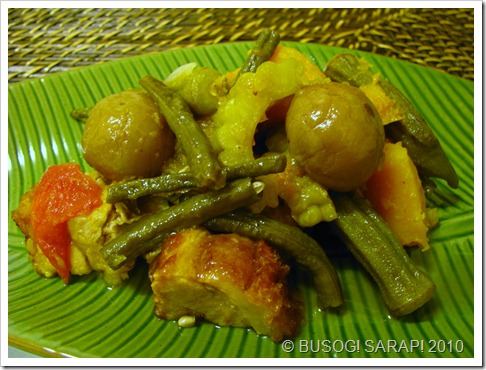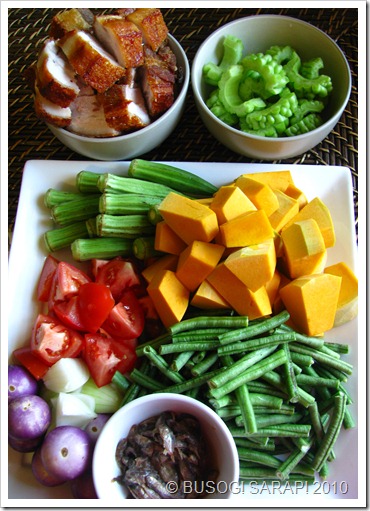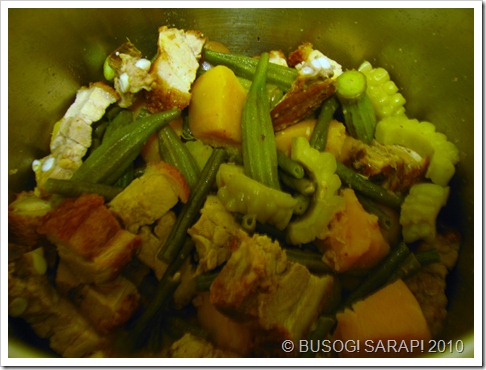
I was very intrigue in making a Ilocano Pinakbet (vegetables/pork or fish/fish bagoong, boiled in its own juices) for a long time. Every time I cook “Tagalog Pinakbet”, Mr. H always tell me that’s not how you cook Pinakbet in Ilocos. Unfortunately during my holidays in the Philippines, I never have the chance on trying a Ilocano Pinakbet version. The “Tagalog Pinakbet” version that I grew up with was sautéed and cooked with shrimp paste (bagoong) and adding cubes of pumpkin was normal. In “Ilocano Pinakbet” version they use a special fish bagoong and they don’t stir the ingredients while it’s cooking, they toss the contents inside the pot while cooking and they add “Bagnet” (Ilocano fried chunks of pork) and pumpkin is not included.
Bitter Melons (Ampalaya) is at its freshest at the moment in Inala, so I thought, I should try out to make Pinakbet. Even though Mr. H said no to the pumpkin, I added it (bad idea, you will know why later!). I’ve deep fried my frozen chunk of pork belly and let it cool while I was prepping my other ingredients. When I showed my fish bagoong (padas) to Mr. H, he said that Mamang use a different fish bagoong. Oh well! the padas bagoong have to do I told him, as I haven’t seen what he was describing to me at the Filipino shops we usually visit.
The reason why I called my version “Pachambet”, because I think it is not worthy to call it as a Ilocano Pinakbet. It is a tasty dish and very simple to cook but while I was cooking it, Mr. H was hovering around the kitchen and every time I ask him if my Pinakbet looks alright to him, he gives me this funny look with a smile, so this made me rethink of a name. The last time I went to the Philippines, the word “pachamba” was popular. One of my cousins told me one time, our “ulam” (dish that you team up with rice) was going to be “pacham” for that night. I thought it was something special and even ask how you cook it, my gulay! was I laughed at….they explained that “pacham or pachamba” means “it accidentally turned out good”. My “Pachambet” falls into that category, it accidentally turned out good even with mushy pumpkin. So, here’s my version of a wannabe Ilocano Pinakbet aka “Pachambet”.
INGREDIENTS:
1kg deep fried pork belly, chunky cubed
7 small round eggplants
2 tomatoes, cut into quarters
1 medium onion, cut into quarters
1 medium bitter melon (ampalaya)
1/2 medium pumpkin (*optional*)
10 strands of snake beans (sitaw)
12 pieces of okra
4 tspn patis
1/4 cup of padas fish bagoong (preserved salted small fish)
1/8 cup water
*used U.S Measuring Cups & Spoons

COOKING PROCEDURE:
Cut the bitter melon (ampalaya) in the middle, lengthwise. With a spoon, scrape the seeds and pulp, cut into semi rings (like in the picture above). Soak in cold water while you prep the rest of the ingredients.
Scrape the seeds and pulp from the pumpkin and cut into wedges and then into chunky cubes. I then individually sliced out the skin and trim the inner soft side of the pumpkin as this method is easier for me. Once you trimmed all the pumpkin cubes, rinse off with water and set aside.
Rinse the round eggplants and okra, cut the tops off. Cut the snake beans (sitaw) into 5cm lengths, rinse with water and drain.
Combine the padas bagoong and water, mash with the back of the spoon to extract the flavour out off the little fishes.

In a medium pot, layer in order: tomatoes (slightly tear them apart), onion, cubes of fried pork belly, sitaw, pumpkin, bitter melon (ampalaya), okra and round eggplants. Drizzle with the padas bagoong water and add in the patis.
Cover the pot with the lid and once the broth started to boil, simmer in medium-low heat. Never take the lid off, cook for 15-20 minutes. With one pot holder in each hand, tightly hold the pot handles and lid together and toss/shake the pot so that the ingredients are jumbled together for even cooking. Do the toss/shake a couple of times during the cooking process.

BEST WITH: Freshly cooked steamed rice and fried fish.
NOTES:
- Next time I cook this, I won’t add pumpkin as it’s too fragile for the toss/shake routine.
- Using Padas bagoong instead of shrimp paste bagoong, gives this dish a milder and smoother flavour. The Padas bagoong flavour blends so well with the rest of the ingredients.
- You can use young Moringa pods (bunga nang malunggay), patani and sigarilyas (frilly winged beans).
- You can either lightly sprinkle some salt on the sliced bitter melon (ampalaya) and let it stand for a few minutes than rinse them well with water or just soak them in cold water to eliminate some of its bitterness.
- I will cook this again with Bagoong Monamon (anchovy bagoong) next time and will replace the round eggplant with mini Lebanese eggplant as the round ones have lots of seeds.






hahaha pachamba chamba lang! That's what I usually do when cooking... more like bahala na if it works then great if not then abandon that recipe! Hehe kidding. this looks great though - pakbet is one of my most favourite filipino dishes ever! put galunggong, bagoong, fried pork, or anything in there and I'll be a happy kid! :)
ReplyDeletethat looks delicious! i have a couple of filipino friends that can't really name a lot of filopino food. this dish looks really good!
ReplyDeletei like this lil blog of yours :)
hehhehe yhanks..sa site na to..,may assignment na akong maipapasa..hahaha
ReplyDelete@Anonymous ~ make sure that your assignment is done in your own words not "cut and paste", glad that you find my pachambet recipe useful:)
ReplyDeleteHi, how do you know when it is already done? (since you said not to open the lid) Thanks.
ReplyDelete@Anonymous~ the 15-20 minutes simmering in medium-low heat is enough to cook the dish, just open the pot and test the veges with a fork (if it pierces easily it is done)after 15 minutes cooking time, if they are still hard, cook for a further 5 minutes. Turning the stove off after cooking and leaving the pot with the lid will further cook the dish because of the leftover heat.
ReplyDeletehi cusinera...try sweet kamote instead of kalabasa..it will make the broth thicker and yummier..i also do pacham too, sometimes my kids hate it..then we call in the mr jolibee..hehehehe....
ReplyDelete